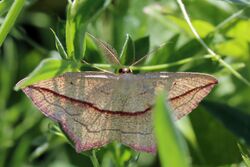Biology:Blood-vein
| Blood-vein | |
|---|---|

| |
| Scientific classification | |
| Domain: | Eukaryota |
| Kingdom: | Animalia |
| Phylum: | Arthropoda |
| Class: | Insecta |
| Order: | Lepidoptera |
| Family: | Geometridae |
| Genus: | Timandra |
| Species: | T. comae
|
| Binomial name | |
| Timandra comae Schmidt, 1931
| |
The blood-vein (Timandra comae) is a moth of the family Geometridae. The species was first described by Anton Schmidt in 1931.
Distribution
It has a scattered distribution in western and central Europe north of the Alps. In the British Isles the distribution is patchy outside southern England and Wales. In far eastern Europe – east of a line running roughly from Finland through Estonia – it is replaced by its sister species Timandra griseata. The species were split in 1931, only to be subsequently re-merged by most authors. But since 1994, new research has come out in favour of treating them as distinct species.[1]
Description
The wings are cream coloured with bold red or purple fascia forming a diagonal stripe across forewings and hindwings. All wings are fringed with the same colour. The tornus of the hindwing is sharply angled giving a distinctive shape. The wingspan is 30–35 mm.
Biology
Two broods are produced each year with the adults flying in May and June and again in August and September.[lower-alpha 1] It flies at night and is attracted to light.
The larva is grey brown with darker spots on the back. In the UK, it feeds on the leaves of a variety of plants including dock, knotgrass, sorrel and various species of Atriplex. It overwinters as a larva.
Notes
- ↑ The flight season refers to the British Isles. This varies in other parts of the range.
References
- ↑ Õunap et al. (2005)
Bibliography
- Chinery, Michael (1986). Collins Guide to the Insects of Britain and Western Europe 1986 (Reprinted 1991)
- Õunap, Erki; Viidalepp, Jaan & Saarma, Urmas (2005). "Phylogenetic evaluation of the taxonomic status of Timandra griseata and T. comae (Lepidoptera: Geometridae: Sterrhinae)". European Journal of Entomology, 102: 607–615.
- Skinner, Bernard (1984). Colour Identification Guide to Moths of the British Isles 1984
External links
Wikidata ☰ Q474600 entry
 |


